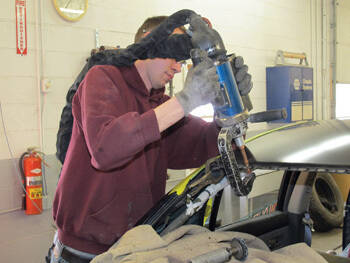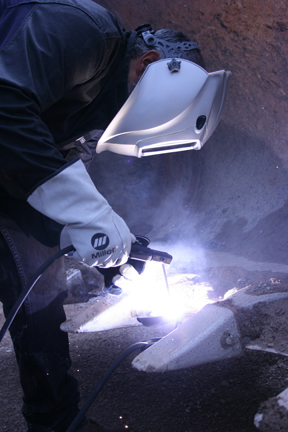Montana Mobile Welding and Repair Welding shares insight on addressing heat distortion effectively
Everything about Welding: Key Insights Into Techniques and Finest Practices for Success
Welding includes a selection of strategies, each suited for specific materials and applications. Recognizing these techniques, such as GMAW, SMAW, and TIG, is important for accomplishing suitable outcomes. Furthermore, the best equipment and security techniques can not be neglected. As prep work and repairing play important roles in the welding process, understanding these elements can substantially boost the high quality of the final item. What are the vital elements that ensure an effective weld?
Recognizing Different Welding Methods
Welding methods encompass a selection of techniques, each suited to particular applications and products. Among the most usual methods are Gas Steel Arc Welding (GMAW), Shielded Steel Arc Welding (SMAW), and Tungsten Inert Gas Welding (TIG) GMAW, likewise understood as MIG welding, is preferred for its speed and adaptability, making it excellent for thin materials. SMAW, or stick welding, is preferred for its simpleness and performance in outside environments, specifically with thicker metals. TIG welding supplies precision and control, making it ideal for complex job and non-ferrous metals (Belgrade). Each technique has its one-of-a-kind advantages and factors to consider, allowing welders to pick the very best approach based on the task's requirements, material type, and wanted end results. Recognizing these methods is necessary for successful welding
Essential Welding Devices and Tools
While numerous welding methods need details abilities, the best tools and tools are equally important for accomplishing quality outcomes. Important welding devices includes welding makers, which differ depending on the method-- such as MIG, TIG, or stick welding. Safety equipment, including handwear covers, aprons, and safety helmets, assurances safety and convenience throughout the process. On top of that, fixtures and clamps aid secure materials in position, making sure precision in welds. Consumables like welding poles, cable, and protecting gas are additionally essential components that influence the high quality of the weld. Additionally, tools such as cutters and mills promote surface area preparation and post-weld finishing, adding to a professional outcome. Spending in high-quality tools eventually boosts the performance and performance of welding tasks.
Safety And Security Practices in Welding
Appropriate security practices are necessary in the welding market to shield employees from prospective hazards. Welders must put on proper personal safety tools (PPE), including helmets with proper shading, handwear covers, and flame-resistant clothing. Appropriate air flow is important to reduce exposure to hazardous fumes and gases created during the welding procedure. Additionally, workers must be trained in the correct handling of welding equipment to prevent crashes. Fire precaution, such as keeping combustible materials away from the welding area and having fire extinguishers conveniently available, are required. Normal examinations of devices and offices can help recognize prospective threats before they cause accidents. By sticking to these safety techniques, welders can create a safer working setting and minimize threats related to their profession.
Readying Products for Welding
Preparing materials for welding is a crucial action that substantially affects the quality and stability of the end product (Belgrade). Appropriate prep work involves cleaning the surface areas to get rid of pollutants such as rust, oil, and dirt, which can endanger the weld. Strategies such as grinding, sanding, or making use of solvents are generally used to achieve a clean surface. Furthermore, making sure that the products mesh snugly is vital; spaces can result in weak welds. It's likewise essential to think about the alignment and positioning of the parts, as this will impact the convenience of welding and the last outcome. Lastly, selecting the suitable filler material and making sure compatibility with the base steels is crucial for accomplishing solid, long lasting welds
Tips for Getting High-Quality Welds
Achieving premium welds requires interest to information and adherence to ideal methods throughout the welding procedure. Appropriate joint preparation is necessary, ensuring surfaces are cost-free and clean from impurities. Picking the proper filler product and welding technique based upon the base steels is vital for optimal bonding. Keeping consistent traveling rate and angle while welding can advertise and protect against defects uniformity. In addition, controlling warmth input is vital; too much heat can lead to warping and weakened joints. If essential, on a regular basis examining the welds throughout the process permits for instant changes. Using proper post-weld treatments, such as cleansing and tension relief, can improve the longevity and honesty of the weld, eventually making certain an effective end result.
Repairing Usual Welding Issues
Welding commonly provides challenges that can impact the top quality and honesty of the last product. Typical issues such as porosity, inconsistent weld beads, and getting too hot can arise, each needing specific troubleshooting strategies. Recognizing these troubles is vital for welders to improve their abilities and achieve perfect outcomes.
Porosity Troubles Discussed
Although porosity can frequently be overlooked, it continues to be an important concern in welding that can endanger the integrity of a finished product. Porosity describes the existence of small gas pockets within the weld bead, which can lead and compromise the joint to early failure. This trouble commonly occurs from contaminants, moisture, or inappropriate shielding gas insurance coverage during the welding procedure. To mitigate porosity, welders need to confirm that the base products are clean and completely dry, use ideal securing gases, and keep constant welding parameters. Consistently checking the equipment and environment can additionally assist identify potential problems prior to they show up in the weld. Resolving porosity effectively is vital for attaining strong, sturdy welds that meet quality requirements.

Irregular Weld Beans
Inconsistent weld grains can considerably impact the quality and stamina of a finished product. Numerous elements add to this issue, including inappropriate travel rate, wrong amperage setups, and irregular electrode angles. When the welder moves also rapidly, a bead might appear narrow and lack penetration, while relocating too slowly can trigger extreme buildup. In addition, utilizing the incorrect amperage can lead to either undercutting or too much spatter, both of which compromise weld stability. The welder's strategy, such as irregular torch activity, can additionally cause uneven grain look. To mitigate these troubles, welders ought to concentrate on maintaining stable, regulated activities and making sure appropriate devices setups to accomplish harmony in their welds. Uniformity is key to achieving strong and reliable welds.
Getting Too Hot and Warping Issues
Too much warmth throughout the welding process can result in significant getting too hot and contorting issues, influencing the structural stability of the workpiece. These troubles frequently show up as distortion, which can endanger positioning and fit-up, making more assembly testing. Elements adding to overheating include the selection of welding criteria, such as voltage and travel rate, as well as the kind of product being bonded. To alleviate these concerns, welders ought to preserve consistent travel speed and ideal warmth input while keeping an eye electrofusion welding on the work surface temperature. Additionally, preheating or post-weld warm treatment can assist minimize tensions triggered by rapid cooling - Montana Mobile Welding and Repair Belgrade. Normal inspection and adherence Recommended Site to ideal techniques are vital in stopping overheating and making certain the longevity and dependability of bonded structures
Often Asked Concerns
What Are the Career Opportunities in the Welding Industry?
The welding market uses diverse occupation possibilities, consisting of settings as welders, instructors, engineers, and assessors. Specialists can operate in manufacturing, building, aerospace, and vehicle industries, benefiting from strong need and affordable incomes in numerous functions.
Exactly How Can I Enhance My Welding Speed Without Giving Up Quality?
To enhance welding speed without giving up high quality, one must exercise efficient methods, preserve equipment, enhance setups, and enhance hand-eye sychronisation. Routine training and looking for feedback can also substantially contribute to attaining quicker, top quality welds.
What Qualifications Are Offered for Welders?
Countless qualifications exist for welders, including those from the American Welding Culture (AWS), the National Facility for Construction Education and Study (NCCER), and numerous industry-specific organizations. These credentials enhance employability and demonstrate skill effectiveness.
How Does Welding Affect the Features of Metals?
Welding influences the buildings of steels by altering their microstructure, which can result in modifications in solidity, toughness, and ductility. Warm input and air conditioning rates throughout the procedure significantly affect these material qualities.
Can I Bonded Dissimilar Metals Together?
